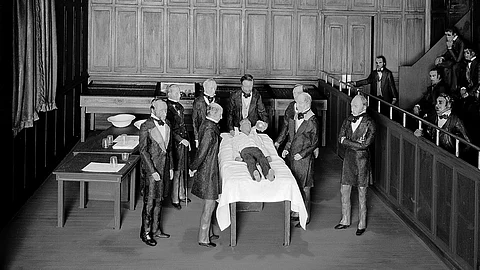

On October 16th, 1846, in the surgical amphitheater of Boston's Massachusetts General Hospital, William Morton, an American dentist gave the first successful demonstration of anesthesia using nitrous oxide. He administered nitrous oxide on the left side of the neck to a patient named Glenn Abbott, before undergoing the surgical removal of a vascular tumor. The surgery was performed by a well-known surgeon named John Warren. After the successful administration, Warren said, "Gentlemen, this is no humbug," and Morton received a patent for the anesthetic use of nitrous oxide.
But before Morton, it was Horace Wells who first discovered the anesthetic effect of nitrous oxide. Initially, he tried nitrous oxide on himself letting his fellow dentist, John Riggs extract his tooth. After its successful completion, he tried it on 12 patients. But when he publicly demonstrated it in front of medical students at Massachusetts General Hospital in Boston, the patient cried out in pain. However, the patient admitted that even though he cried at first he didn't experience pain. Later, it was discovered that nitrous oxide does not work on obese or alcoholic patients, and that patient was both obese and alcoholic.
After Morton's successful administration, Warren wrote letters to publications regarding his trials which were conducted before. But his efforts went in vain. However, the Parisian society honored him as the pioneer who discovered and performed surgical operations without pain. This happened 12 days before his death, and he died unaware of these decisions. Horace Wells is regarded as the 'Father of anesthesia'.
Nitrous oxide is an inhalation anesthetic and is also known as 'laughing gas' because it provides a tingling sensation followed by a euphoric effect. During the initial days of discovery, the gas was administered to the patients using a simple breathing bag made of rubber cloth. Later, the method was changed to administering it through a mask attached to a gas cylinder.
Following are the clinical features of Nitrous oxide:
Low potency
Colorless and odorless
Non-inflammable
Smooth onset and rapid recovery
Insoluble in water but 15 times more soluble than oxygen.
Three main effects of nitrous oxide are:
1. Analgesic
2. Anxiolytic
3. Euphoric
Some of the advantages of nitrous oxide are;
Easy administration
Safe with limited side effects
Fast action and fast recovery
Controls anxiety toward the treatment
The level of sedation can be adjusted.
Even though nitrous oxide is considered safe, it is not recommended for everyone. Nausea, dizziness, fatigue, shivering, etc. are the common side effects. Some people may experience allergic reactions like hives, wheezing, fever, chills, etc. Nitrous oxide does not provide post-treatment pain control.
Nitrous oxide is contraindicated in the following cases:
The first and second trimester of pregnancy. In third trimester it is administered only after careful examination.
Deficiency of vitamin B12 or cobalamin.
History of mental or behavioral health problems
History of chronic pulmonary obstructive disease(COPD) and other respiratory issues.
Patients with deviated nasal septum, nasal polyps, rhinitis and sinusitis.
Patients who have undergone recent ear surgery.
Why is nitrous oxide not used by dentists anymore?
Nitrous oxide can cause nausea and dizziness in some patients. If not administered properly, it can be harmful. Nitrous oxide is not a strong anesthetic and pain may arise after treatment. Nowadays, there are many better and more effective ways to relieve pain in patients that have fewer side effects.
Which anesthetic is used in dentistry today?
Currently, local anesthesia is used widely for dental procedures. Lidocaine is the most commonly employed local anesthesia followed by prilocaine, articaine, and bupivacaine. Local anesthesia is very effective and can last up to 30 to 60 minutes. Infiltration and regional nerve block are two methods of delivering local anesthesia.
Sedation is indicated in uncooperative pediatric patients or in cases where general anesthesia is required.
Nitrous oxide outside dentistry
Nitrous oxide is commonly used during trauma, childbirth, and emergency care. During childbirth, it is considered safe for both mother and child. In many European countries and Australia, it is used widely for labor pain relief. If the pain increases during labor, then an epidural is given. Nitrous oxide is often kept in the emergency department of hospitals for people with anxiety before short procedures. It is administered to small children through a mask that is attached to gas cylinders, while older children and adults are asked to hold the mask on their faces.
